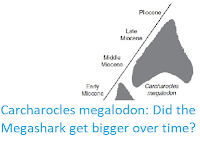Sharks first appeared during the Devonian, and are still dominant predators in the seas of today. They form an important part of the marine fossil record in many areas,
and are occasionally used for stratigraphy (dating rocks), though often
they are usually only represented by their teeth, which are mineralised
and grown and shed throughout their lives. Despite this, as with all groups. there are gaps in their fossil record, with areas where, despite apparently having good Shark habitats, Sharks remains are absent from the fossil record. One such area is southwestern Gondwana (South America and Antarctica), where Shark remains are common from the Late Cretaceous and Cainozoic, but almost entirely absent from the Jurassic and Early Cretaceous.
In a paper published in the journal Cretaceous Research on 13 September 2017, Soledad Gouiric-Cavalli and Alberto Cione of the Divisi on Paleontología Vertebrados at the Museo de La Plata, and the Consejo Nacional de Investigaciones Científicas y Técnicas, and Darío Lazo, Cecilia Cataldo, and María Aguirre-Urreta, also of the Consejo Nacional de Investigaciones Científicas y Técnicas, and of the Instituto de Estudios Andinos “Don Pablo Groeber” at the Universidad de Buenos Aires, describe two partial Shark specimens from the Early Cretaceous Agrio Formation of Neuquén Province in Argentina.
The first specimen described is a partial spine from the dorsal fin of a Hybodont Shark, a group of highly distinctive Sharks that appeared in the Devonian and which are generally thought to have become extinct at the End of the Cretaceous. This is incomplete, and broken into two fragments, but is extremely distinctive, with a pulp cavity, a keel on its foreward surface, and a series of denticle bases on its rear surface, features not seen in anything other than the spines of Hybodonts.
The second specimen described is a partial tooth assigned to an unknown member of the genus Protolamna, a group of Mackeral Sharks that went extinct at the end of the Cretaceous. This is a small tooth, only 4 mm in height, though the tip of the cusp is missing.
See also...
Hybodontiformes fin spine. (A) Silhouette of the fin spine in which preserved parts are shown. (B)-(C) Posterior fin spine margin to show the denticle bases. (D) Cross section of the fin spine in their anterior margin at level illustrated in (A) with a circle. (E) Close-up of (B) to show denticle bases. (F) Cross section of the fin spine at level shown in (A). Scale bars are 20 mm in (A) and (C), 2 mm in (D), and 3 mm in (E) and (F). Gouiric-Cavalli et al. (2017).
The second specimen described is a partial tooth assigned to an unknown member of the genus Protolamna, a group of Mackeral Sharks that went extinct at the end of the Cretaceous. This is a small tooth, only 4 mm in height, though the tip of the cusp is missing.
Protolamna sp. (A) Labial view. (B) Lingual view. Scale bar is 2 mm. Gouiric-Cavalli et al. (2017).
See also...
Follow Sciency Thoughts on
Facebook.








